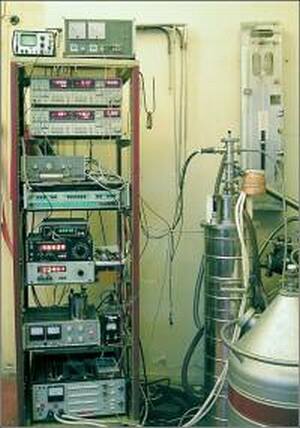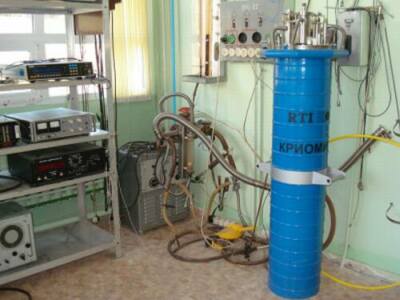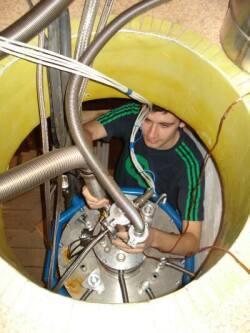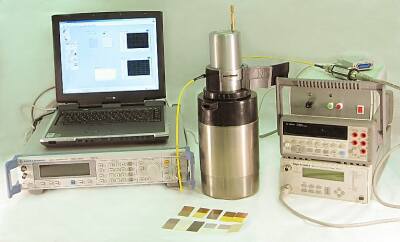|
|
|
|

The Laboratory of
Electronic Kinetics (LEK) has powerful radio-frequency,
microwave, cryogenic and high-magnetic-field sets
of equipment, allowing to carry out precision phase-sensitive
measurements of current and voltage in a frequency
range 0-10 MHz and the microwave response of crystalline
materials in cm-and mm- wavelength range in the
temperature interval (0.1-300) K and in magnetic
fields up to 18 T. Methodical principle of LEK development
allows to investigate the same sample by different
physical methods and to get the maximal information
on its electron properties. Recently discovered
transition from classical superconductivity to unusual
one in crystals Ba1-xKxBiO3
can serve as a successful example of such approach
[in more detail]. This
effect was found by the measurements of temperature
dependences of the upper critical field and a superconducting
impedance: in crystals with Tc> 20 K (a and b
in the left figure) temperature dependences of the
upper critical field have positive curvature, and
with Tc <15 K (c,
d, e)
are described by standard dependence; in full correlation
with such behavior of a critical field the impedance
of crystals below the critical temperature shows
either linear or exponential (crystal
c, the right Figure) behavior respectively.
|
During 2003-2007
years the Laboratory was equipped with the advanced
and expensive measuring techniques. Developed and
tested in LEK the superconducting solenoid with
a magnetic field as high as 18 T at T=4.2 K, and
cryogenic systems (the Patent N 46084 "Low-temperature
insert for the cryostat with pumping out of He3
vapor for operation in a range (0.3-300) K ")
is in active demand of researchers both from our
country and from abroad. This is confirmed by the
fact that more than 10 treatments, utilizing the
LEK equipment for scientific and technical collaboration
with universities, institutes of the Russian Academy
of Sciences (RAS) and scientific research institutes
of the Russian Federation, were arranged within
last several years. For the period 2002-2006 LEK's
cryo system has been made (duplicated) for 5 institutes
of the RAS: Institute of Metal Physics Ural Division,
Institute of Semiconductor Physics Siberian Branch
of RAS, Institute of Radioengineering and Electronics,
Institute of Microelectronics Technology and High-Purity
Materials, Lebedev Physical Institute; special low-temperature
microwave equipment on the basis of the gold 9.3
GHz frequency resonator has been made for the University
of Palermo (Italy). During this period several scientists
from abroad worked in LEK: Italian researchers from
the University of Palermo (more than half a year),
the scientific researcher from Baku Institute of
Physics (Azerbaijan) (about one year), and also
employees (each during the month) from the Institute
of Radioengineering and Electronics of RAS, Institute
of Semiconductor Physics Siberian Branch of RAS,
Institute of Metal Physics Ural Division of RAS,
Institute of Inorganic Chemistry Siberian Branch
of RAS and Institute of Problems of Chemical Physics
of RAS. As a result of this collaboration 10 papers
with participation of researchers from Russian and
foreign scientific institutions in 2004-2006 were
published in leading scientific journals. LEK's
equipment is permanently used by students and post-graduate
students of the Solid state physics faculty of Moscow
Institute of Physics and Technology for scientific
researches.
|
The Laboratory steadily
expands its methodical opportunities. The works
are started on:
-
creation of the universal
microwave setup for studies of high-frequency
properties of samples in a millimeter range
of wavelengths from room down to ultra-low temperatures
and in magnetic fields up to 18 T
-
improvement of cryosystems
for more easy access to the liquid He3
volume (T=0.3 K) for various, including comparatively
bulky devices (systems for sample rotation,
wave guides, optical paths, etc.)
-
development of the
original dilution refrigerator for low (down
to 50 mK) temperatures
-
the creation of a
method for measurements of shot noise of a current
in mesoscopic bridges at high temperatures when
the thermal noise prevails.
-
development of non-resonant
spectral method of refraction factor measurements
in metamaterials in the frequency range from
0.1 up to 40 GHz
|
|
Equipment
complexes for the studies of electromagnetic properties
of new materials include:
|
The automated equipment
for the low-frequency measurements of semiconductor, metal
and superconductor conductivity allowing to study:
-
Temperature dependences of sample resistance
in a temperature range (0.3 - 300) K. The four-contact
measurement technique is developed for studying
the anisotropic samples (high - temperature
superconductors, organic metals, layered semiconductors),
allowing to define both resistance anisotropy
and the components of the resistivity tensor
on the samples with the size as small as 0.2
mm.
Inserts for the express measurements
in liquid helium Dewar in the temperature
range (4.2 - 300) K.
- Magneto resistance of the normal metal and semiconductor
samples as well as the temperature dependences
and the anisotropy of the upper critical field
in superconductors in the temperature range (0.3
- 300) K and in magnetic fields up to 18 T. The
cryostats with superconducting solenoids and the
inserts with He3
pumping out are used for such measurements.
|
|
A sample with the size of 0.2 mm
The four-contact measurement technique
|

|
For the listed measurements the high-sensitivity
equipment operated by computers on the basis of
modern Lock-in amplifiers SR and PAR and digital
multimeters Agilent and Solartron is used
|

Typical cryostat with 14 T solenoid
|

The superconducting solenoid developing a stationary
magnetic field 18 T at liquid helium temperature
T = 4.2 K
| |
|
Original cryosystem for precision
sample conductivity and dynamic susceptibility
measurements in the frequency range from 10
Hz up to 10 MHz at the temperatures (0.3-300)
K in a magnetic fields up to 8, 12, 14 and
18 T, created by superconducting solenoids
| |
|
Original microwave devices
for precision temperature dependence measurements
(from 0.4 K up to 200 K) of real and imaginary
parts of a surface impedance of the samples
in cm- and mm- ranges of wavelengths
| |
|
Original dilution refrigerator
for the measurements at ultra low (down to
50 mK) temperatures in strong magnetic fields,
created by superconducting solenoids
| |
|
The automated setup for the express measurements
of a dynamic magnetic susceptibility of the samples
in a temperature range (2 - 300) K
|
|
|
- Sensitivity 10-9 emu
- An alternative magnetic field amplitude
(0.1-10) Oe
- Frequency of an alternative field - up to
10 MHz
- Magnetic field up to 18 T
- The characteristic feature of the setup
is that electromagnetic coils are immersed
into a liquid helium (T = 4.2 K) during the
measurements of susceptibility temperature
dependences, which provides high stability
of the amplification factor
| |
|
The original microwave setups
allowing to carry out precise temperature dependence
measurements of real R (T) and imaginary X (T)
parts of the surface impedance Z (T) on the
samples of the small size (the surface area
about one square millimeter) in centimeter and
millimeter ranges of wavelengths. These setups
include two basic elements: super high-stable
generators of Agilent Technologies Company (USA)
with 0.01 Hz frequency resolution in a frequency
range from 200 KHz up to 40 GHz and low-temperature
high-vacuum devices on the basis of superconducting
Nb resonators with good quality factor at T=
2 K, greater than 10 and 2 millions on the frequencies
10 and 30 GHz respectively. Surface resistance
R (T) of the sample is measured with accuracy
about 1 mikro Ohm and electromagnetic field
penetration depth in the sample with an error
smaller then 5 nm. Now these parameters are
the best in the world. Experimentally
obtained values R (T) and X (T) in absolute
units (Ohms) for different orientations of the
sample with respect to a microwave field in
the resonator allow to find the components of
the complex conductivity - the main electrodynamical
characteristic of the sample, both in normal
(up to T= 300 K), and in superconducting (down
to T= 0.4 K) states of the investigated sample.
| |
| The original setup for
studies of microwave properties of dielectric
films and their cap-layers in a range of
frequencies from 25 up to 40 GHz, allowing
to measure: |

|
-
dielectric permeability of
the films with the thickness from 50 microns
to 1 mm in the permeability range from 2
to 1
-
loss tangent of dielectric
films in an interval from 0.1 to 0.0001
-
microwave conductivity and
a surface impedance of the copper film,
measured from dielectric substrate side
-
temperature dependences of
all specified above characteristics in an
interval from -60 C up to +70 C
| | |
|
|
|
| |
|
|
|
|